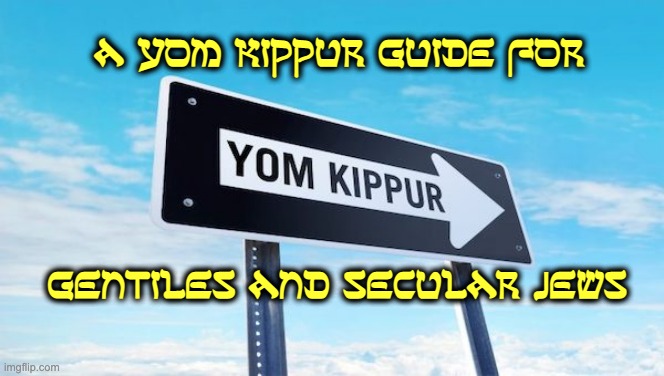Tuesday night (10/4/22)_ at sundown begins the holy fast day of Yom Kippur. To my Friends in the Gentile community, we would like to help you understand the holiday, so you will understand what we will be doing.
Some crazies believe it is not really a religious holiday. But to that people, your belief is not true that Yom Kippur is a day the WWJC gets together and plans out the control of the banks, Congress, and the media. Those claims aren’t true. For example, if we ran the banks, we would cancel your cash cards and all your money to a charity.
For those who are not riding the crazy train, here’s a true explanation of Yom Kippur: Most Americans have heard of Yom Kippur and loosely know it’s a fast day. But do you know what’s really happening behind the walls of your friendly neighborhood Synagogue or a Jewish neighbor’s house? The below tries to explain Yom Kippur to you in a way you might enjoy…at least it won’t be too Jewish, which is something that Gentiles and secular Jews will appreciate.
Yom Kippur is one of only two 25-hour fasts on the Jewish calendar (the other is Tisha B’av). Tisha B’av is a sad fast as Jews memorialize all the bad things that happened to Jewish people on that day, and there were many. The two most serious were the destruction of the first and second Beit HaMikdash (Holy Temple) of God atop Mount Moriah in Jerusalem.
Yom Kippur is a happy fast. Jews are working hard to get close to God, which is the greatest joy possible. In Biblical times it was the one day a year that the high priest was allowed to enter the “holy of holies,” the most sacred part of the Temple. Note; High Preist (Kohen Gadol) is a job title. He didn’t smoke a doobie. The first Kohan Gadol was Moses’ brother Aaron. Moses and Aaron were the first brothers in the Torah who got along an indication the people were ready to become a united Jewish nation.
Observing Yom Kippur in Biblical times
In Biblical times, the High Priest entered the Holy of Holies, a chamber inside the Beit HaMikdash, which is said to host God’s neshama (spirit). The priest would pray on behalf of the “Jewish” people and assure the Almighty that the Children of Israel have atoned.
During the first temple period, the Ark of the Covenant, containing, among other things, the stones the ten commandments were written on well as the broken version that Moses threw down when he saw the people praying to the golden calf.
Only the Kohan Gadol was allowed in the holy of holies. He was only allowed to enter on Yom Kippur. We are told that when the Kohan Gadol entered the Holy of Holies, a rope was tied to his ankle. If he went in without properly atoning, he died while in that holy sanctury. As no one but the high priest was allowed to enter, the only way to get a dead high priest out of the “holy of holies ” is to pull him out by the rope attached to his foot–proof that God took the atonement thing seriously.
There hasn’t been a Jewish temple since the destruction of the second Temple.
Yom Kippur In Modern Times
In modern times Jews fast. Fasting on Yom Kippur means giving up much more than food. We give up nourishment, sex, washing, applying lotions or creams, and leather footwear. But let’s face it, after giving up food and sex, do the other three really matter?
A True Yom Kippur Story. Sandy Koufax made national headlines when he refused to pitch in the first game of the 1965 World Series because it fell on Yom Kippur. When Koufax’s replacement Don Drysdale was pulled from the game for a poor performance (giving up seven runs in less than three innings), he said to Los Angeles Dodgers manager Walter Alston, “I bet you wish I was Jewish, too.”
What Gentiles Should Do On Yom Kippur:
While it’s called the day of atonement, it is not the reason for the fast. Fasting is not meant as a sign of our atonement. We don’t deny ourselves ice cream, suffer caffeine withdrawal headaches, and forgo connubial relations as some sort of sacrifice to God. The Rabbis say we are fasting because we are trying so hard to get as close as possible to our Maker that we don’t have time for the other stuff. That’s why it is a happy fast because we believe there is no greater joy than getting closer to God.
If you are a Gentille and happen to see one of your Jewish friends walking to shul (synagogue) on Yom Kippur, there is no need to hide. Thankfully the caffeine withdrawal headaches or the hunger pangs Jews get on Yom Kippur are not contagious.
Should you want to know what to say to your Jewish friends. allow me to suggest you avoid, “Hey, you hungry yet?” Two good things to say are, “have an easy fast” or “Gmar Chatimah Tova,” which means may God seal you in the book of life.
No, we don’t really believe the creator of the universe spends Yom Kippur sitting on a heavenly throne writing people’s names in a book (if he did, I am sure he would have a powerful iPad-like machine with tons of RAM). The book of life is just a metaphor and not meant to be taken literally. If there was a book of life, just try and imagine the size of the bookshelf where it would be held.
Note to my Gentile friends if you see a Jew walking to Synagogue on Tuesday night, “Hey wanna come over for a beer after Temple,” is NOT a proper greeting either (neither is the term Temple. There were only two Temples in Jewish history, and both were atop the Temple Mount. and the last one was destroyed by the Romans in the year 70 CE.
The mental image of God with the book of life is a theme throughout the ten days of awe, beginning with Rosh Hashanah and ending with Yom Kippur. On Rosh Hashanah, we say may God put you in the book…. and then on Yom Kippur, it is assumed you were put in the book, so we change the idea to may God seal you in the book, possibly with the assumption that God closes the book at the end of the fast. But in the Jewish faith, there are always opportunities to return to the right path. We believe that God welcomes atonement at any time (but it is easier to do it on Yom Kippur when have the support and encouragement of the community ).
Judaism emphasizes community. That’s why the Jewish people are Am Yisrael,” the nation of Israel, instead of “Dat Yisrael,” the religion of Israel. Think of a fireplace. Take one ember out of the fire; it quickly dies, but leave it with the rest of the fire. It continues to burn. The faith of a Jew who remains as part of the community continues to burn in his heart.
The Yom Kippur fast will end an hour and ten minutes after sundown on Wednesday night. Since COVID, Yom Kippur services have been strange. Usually, using a computer or television are taboo on the holiday, even if the Mets are in the playoffs. But for the third straight year, because of CoronaVirus, many American Jews will be attending services via Zoom or a similar program.
Gentiles, Please Note: If you live in a community where there are live, in-person Yom Kippur services, I strongly recommend you stay out of the way when the throng of Jews leaving their Shul and head for nourishment at the end of the holiday. It is more dangerous than getting between Senator Chuck Schumer and a TV camera or Rep. Eric Swalwell and the Chinese Spy Fang Fang.
You will be able to tell the mob is coming because Yom Kippur ends with a loud blowing of the Shofar (it has nothing to do with a man driving a car, it’s a ram’s horn converted into a very loud musical horn).
To help Jews remember the day they spent in fervent prayers, many synagogues (including mine) give the children plastic Shofars as the kids leave the shul at the end of the holiday. The toy shofars are louder than the real ones. These plastic noisemakers incite more prayer. Every time one of those dear children blows that obnoxious-sounding toy. It is the last prayer of the holiday. If you listen closely every time a chlld blows their toy shofar you can hear their parents groaning, “Oh God!”
It is a tradition that after Yom Kippur is over, Jews go to the homes of friends and/or family and consume large quantities of whitefish, bagels, and/or blintzes. There are three reasons for this:
First of all, we can play the time-honored game of who suffered the most:
” You think you had it rough this year? During my fast, I got such a bad headache that one of my eyes popped out of its socket.”
“Oh yeah, my fast was so bad I passed out and went into a coma.”
“You think yours was bad? Heh! Not only do I have the Yom Kippur a headache, but my Rabbi’s sermon was six hours long, and he opied it from the Democratic Party position papers. It was so bad few congregants killed themselves so they wouldn’t have to hear him speak anymore.
The second reason is obvious; people are starving and need to eat. Not everyone has the strength to prepare a meal, so to be fair, we switch it from family to family every year to spread the “burden” around.
The final reason- Jews shouldn’t go near Gentiles (NO, this is not some sort of Hebraic bigotry, nor is it a commandment). We are trying to do Gentiles a favor. Along with the activities I mentioned above, during the 25 hours of the fast, we are not allowed to wash, bathe, or put on any lotion or scent. We haven’t brushed our teeth or used mouthwash either. After almost a full day of hanging out with other Jews in what always seems to be a hot Synagogue, we cease being “God’s chosen people.” Instead, we become “God’s Rather Pungent People.” Therefore after the fast, we tend to hang amongst ourselves because no one else would be able to take the noxious aroma.
Before we end, allow me to wish all my Jewish friends an easy and meaningful fast. And to everyone, both Jew and Gentile:
גמר חתימה טוב
Gmar Chatimah Tova
May you be sealed in the book (or iPod) of life for a happy and healthy New Year.






